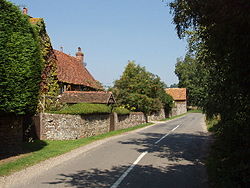Stonor
| Stonor | |
| Oxfordshire | |
|---|---|
 Whitepond Farm, Stonor | |
| Location | |
| Grid reference: | SU7388 |
| Location: | 51°36’7"N, 0°56’20"W |
| Data | |
| Population: | 337 (2001) |
| Post town: | Henley-on-Thames |
| Postcode: | RG9 |
| Dialling code: | 01491 |
| Local Government | |
| Council: | South Oxfordshire |
| Parliamentary constituency: |
Henley |
Stonor is a wooded village centred four miles north of Henley-on-Thames in Oxfordshire. It takes up part of the Stonor valley in the Chiltern Hills, which rises to 394 feet above sea level within this southeast part of the parish.
Stonor House close to the village centre has been the home of the Stonor family for more than eight centuries. The house and park are open to the public at certain times of the year. The house has a 12th-century private chapel built of flint and stone, with an early brick tower.
There are also signs of a prehistoric stone circle in the park, which gives the place name its name: stan ora, Old English for "stone place".[1]
History
For most of its history Stonor was called Upper Assendon and was a hamlet in an exclave of Pyrton parish. In 1896 the detached part was made into a civil parish of Stonor, named after the adjacent country house at Stonor Park. In 1922 Stonor and Pishill civil parishes were merged.[2]
During and after the Reformation the Stonor family and many other local gentry were recusants, adherent to the Roman Church. In 1581 the Jesuit priests Edmund Campion and Robert Parsons lived and worked at Stonor Park, and on 4 August 1581 a raid on the house found a press on which Roman Catholic publications had secretly been printed. The elderly Lady Cecily Stonor, her son John, the Jesuit priest William Hartley, the printers and four servants were taken prisoner, and in 1585 Hartley was exiled.[2]
Despite continued prosecutions and fines the Stonors and a number of Upper Assendon families remained Roman Catholic throughout the 17th and 18th centuries, attending Mass at the Stonors' 12th century private chapel. Between 1716 and 1756 John Talbot Stonor, Vicar Apostolic of the Midland District used Stonor Park as his headquarters.[2] In the first half 19th century the number of Roman Catholics in Upper Assendon increased, partly by local people converting, possibly aided by the fact that the only local school at the time was a Roman Catholic one endowed by the Stonors. The 1851 census recorded 50 Roman Catholics in the village, but in the final quarter of the 19th century the numbers sharply declined.[2]
Stone circle
The house was built on the site of a prehistoric stone circle or henge and this has given it its name. The remains of the circle are still visible with one stone incorporated into the south-east corner of the chapel.[1]
Sport
Stonor Cricket Club was founded in 1797. It has occupied its current ground next to Stonor Park for more than a century.[3]
Outside links
| ("Wikimedia Commons" has material about Stonor) |
References
- ↑ 1.0 1.1 Stonor stone circle - Stonor estate
- ↑ 2.0 2.1 2.2 2.3 Lobel, 1964, pages 98-115
- ↑ Stonor Cricket Club
Sources
- Victoria County History: A History of the County of Oxford: Volume 8: Lewknor and Pyrton Hundreds
- Sherwood, Jennifer; Pevsner, Nikolaus (1974). The Buildings of England: Oxfordshire. Harmondsworth: Penguin Books. pp. 791–794. ISBN 0-14-071045-0.